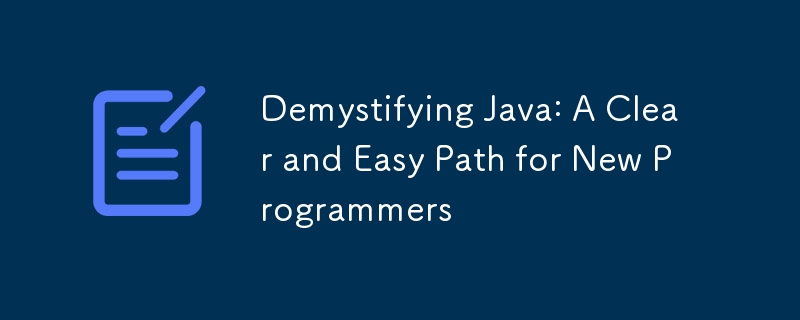Home >Java >javaTutorial >Demystifying Java: A Clear and Easy Path for New Programmers
Demystifying Java: A Clear and Easy Path for New Programmers
- PHPzOriginal
- 2024-10-10 13:34:011030browse
Learn Java without worrying! This guide provides clear steps to take you on your programming journey. Java is an object-oriented language that uses objects to store data and operations. Practical case: HelloWorld code demonstrates basic syntax and program structure. Java provides various data types and variables. Code blocks and conditional statements control code flow. Arrays and collections help manage data. By following the examples in the guide, you'll gain a solid foundation in Java programming and be prepared to become a skilled programmer.

In-depth Java: A clear and easy way for novice programmers
Learning Java? don’t worry! This article will take you on an easy and seamless journey to coding so you can start coding in no time.
Learn Java Basics
- Java is an object-oriented programming language, which means it is built around entities called "objects".
- Objects contain data (properties) and operations (methods).
- Java code runs in a virtual machine (JVM), which provides code consistency across multiple platforms.
Practical case: HelloWorld
Create a new file in the command lineHelloWorld.java and enter the following code:
public class HelloWorld {
public static void main(String[] args) {
System.out.println("Hello, Java!");
}
}-
public classdefines a class namedHelloWorld. -
public static void mainis the entry point of the program. -
System.out.printlnPrints the text "Hello, Java!" to the console.
Save the file and run the following command:
javac HelloWorld.java java HelloWorld
voila! "Hello, Java!" is printed on the console.
Data Types and Variables
- Java has multiple data types to store different types of data such as numbers (int, float, double) and strings (String).
- Variables are used to reference data and have a type and name.
Code Blocks and Conditional Statements
- A code block is a group of statements grouped together using curly braces ({}).
- Conditional statements (such as if-else) are used to perform different actions depending on whether a certain condition is true or not.
Arrays and Collections
- Arrays are ordered sequences of elements that can easily store and access large amounts of data.
- Collections such as lists and sets can represent more complex data structures.
Practical case: Array
CreationArrayDemo.java:
public class ArrayDemo {
public static void main(String[] args) {
int[] numbers = {1, 2, 3, 4, 5};
for (int i = 0; i < numbers.length; i++) {
System.out.println(numbers[i]);
}
}
}- This code creates an array named
numbersinteger array. - Loop through the array and print each element.
Conclusion
This article lays a solid foundation for getting started with Java, covering core concepts, practical cases and basic programming elements. With continued practice and exploration, you will quickly become a proficient Java programmer.
The above is the detailed content of Demystifying Java: A Clear and Easy Path for New Programmers. For more information, please follow other related articles on the PHP Chinese website!

